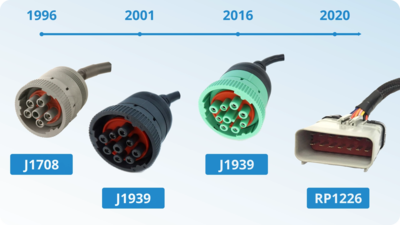Equipment failure is a major safety concern in the trucking industry, as it can cause accidents and breakdowns which often can lead to delays and increased costs. While equipment failure can occur for a variety of reasons, such as manufacturer defects or wear and tear, according to the causation studies by the National Highway Transportation Safety Administration (NHTSA), negligent maintenance is a factor in about 40% of truck crashes. In this edition of Fleet Safety 101 we highlight poor maintenance practices and how technology- such as TruckSpy's data gateway- can streamline and improve fleet safety. Keep in mind, the data gateway is not an additional device that has to be plugged into your truck. On top of hours of service (HOS) and electronic logging device (ELD) functionality, it also does diagnostic trouble codes (DTC) and fleet GPS tracking. An optional but highly recommended piece of hardware is the plug-and-play TruckSpy AI dash cam. Let's see if your fleet can benefit from this technology. We've identified several poor maintenance telltale signs; here we'd like to highlight three of them: Thorough pre and post trip inspections (PTI), turnaround times and repeat violations.
Pre and Post Trip Inspections
In order to improve equipment maintenance, fleet managers can take several steps. First and foremost, they should extensively train drivers on what a proper PTI looks like, as well as establish a regular maintenance schedule, and perform preventative maintenance. Brakes, for example, are the top cause of maintenance-related crashes. The average semi-truck needs new brakes about every 200,000 to 300,000 miles. Truck drivers will travel anywhere from 60,000 to 110,000 miles per year, meaning they typically need to have their brakes replaced once every 2 to 4 years. If the company doesn’t keep up on maintenance, they could be at serious risk next time they’re taking a high-grade hill or maneuvering through small-town streets, and it all starts with a driver performing a thorough PTI. Since drivers are in their trucks day in and day out they will be the first to identify any potential issues before they can become more serious. Recently on our podcast we sat down with Tracy Lange, an insurance agent from Higginbotham, and he highlighted this exact problem in the industry. Fleets with drivers that perform thorough PTIs usually experience less breakdowns and more savings on insurance premiums. Watch the full podcast here.
Turnaround Time
The duration between a truck issue being reported and its repair is a vital metric to track for fleets. While many focus on the cost of repairs or frequency of breakdowns, it's the turnaround time that can make or break a fleet's efficiency. The longer a truck is out of commission, the more it impacts the fleet's productivity and bottom line. It's crucial to prioritize quick repairs, and tracking turnaround time helps to identify inefficiencies in the repair process and improve overall fleet utilization. One of the key ways fleets can improve turnaround time is by using fleet management software that automatically pulls the PTI report from a driver's' device and send it to your shop or mechanic. TruckSpy's all-in-one fleet management platform does exactly this. Our customers reported they were able to cut down turnaround time from 3 days to 12 hours; our CEO discussed this here.
The Do-It-All Fleet Management Platform.
Start Today, No Contract. No CC.
Repeat Violations
Repeat violations are a clear sign that there are issues with your fleet's maintenance. If a driver is constantly experiencing the same issues, regardless of which truck they are driving, it's possible that the driver is not performing a proper PTI. You might consider removing the driver from the company to prevent further issues and ensure the safety of your fleet. Similarly, if the same truck is constantly experiencing the same breakdowns or violations, then either the underlying problem is not being fixed or that truck may need to be replaced. We recommend operating newer equipment with clear replacement cycles. TruckSpy's data gateway captures vehicle telematics by monitoring vehicle performance and identifies issues before they become major problems. For example, they can use GPS tracking to monitor vehicle speed and idling- which can indicate overuse and abuse- and can then use that information to improve driver training and vehicle use. In both cases, it's important to take action to address the issue and by taking proactive steps to address these repeat violations, which can improve the safety and efficiency of the entire fleet.
In conclusion, equipment failure is a serious safety concern in trucking that can lead to accidents, delays, and increased costs. Luckily, if you keep your trucks properly maintained with proper driver pre trip inspections, use software specifically built for truck fleet dispatch, operations and safety to improve turnaround time and are attentive to repeat driver and vehicle violations you can save yourself from dangerous- even deadly- mechanical malfunctions. If your fleet is in need of a software upgrade or if you'd like to get a free demo of the purpose built, all-in-one fleet management TruckSpy Software please click here.
Recent Blogs
by Elyse Byers
July 5, 2024




